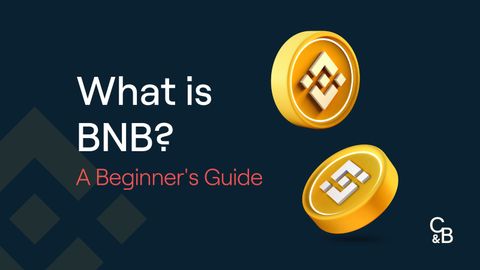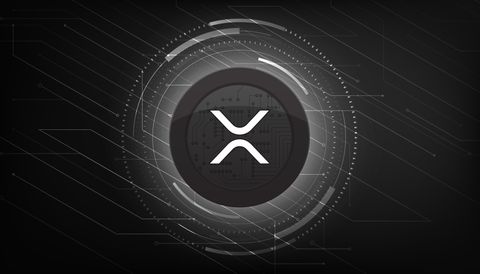Key Points
- Solana was co-founded by Anatoly Yakovenko in 2017, a previous lead systems engineer at Qualcomm.
- Solana’s unique hybrid consensus model touts transaction speeds that rival Visa and Mastercard, along with equally low fees.
- Solana is the first crypto project to introduce the concept of Proof of History (PoH) as a consensus mechanism.
Blockchain technology disrupted the idea of transacting across borders.
It introduced the concept of digital cash transactions without intermediaries. Two parties could exchange value, directly, autonomously, and anonymously. But there was one small issue:
Speed.
With Bitcoin averaging 10 minutes to mine a block, its transaction speed sits around a mere 3-7 transactions per second (TPS). By comparison, Visa could perform up to 24,000 TPS. And although Ethereum improved upon Bitcoin’s end user pain points in new and innovative ways, it faced scaling issues. That said, existing Layer 2 Roll-ups and Ethereum's upgrades to come address these technological constraints.
Keen not to wait, Anatoly Yakovenko went to the drawing board to solve this problem. And he came up with Solana.
In this guide, we’ll look at all that Solana has to offer, a beginner breakdown of how its blockchain operates, and what’s next for the network. Let’s dive in.
What is Solana?
Solana is a third-generation, open-source blockchain, that aims to scale transaction speeds without compromising security and privacy. Similar to Ethereum, Solana is a programmable blockchain, allowing users to create, upload, and/or execute smart contracts. It is also a space for developers to create and publish decentralised apps (DApps). It has evolved to become a marketplace for users to access decentralised finance (DeFi), games, and non-fungible tokens (NFTs).
To perform a high volume of transactions, the network uses a unique hybrid consensus model of Proof of Stake (PoS) and Proof of History (PoH) mechanisms; the first of its kind in blockchain technology. Using this model, Solana exceeded 50,000 TPS in its early testing phases.
SOL is the native token on the Solana network. It is used for making or sending transactions, interacting with smart contracts, and for staking. As of October 31st 2023, Solana has processed around 250 billion transactions.
Recommended reading: What is a Layer 1 Blockchain?
How is Solana different from Ethereum?
At face value, both Solana and Ethereum seem quite similar. They share some core features, and they also seek to build upon concepts laid out by its predecessor, Bitcoin. Beneath the surface though, there are some fundamental differences between the two projects.
Speed and Cost
In its inception, Ethereum focused primarily on creating the first programmable blockchain. The project introduced the concept of smart contracts, giving blockchain technology more real-world utility than Bitcoin had done previously.
Smart contracts turned out to be a groundbreaking innovation, and the network exploded in popularity. However, Ethereum's PoW consensus mechanism at the time was unable to manage this volume of transactions efficiently. While users could pay a premium to get their transactions bumped to the front of the line, even users who opted to send transactions normally had to pay expensive fees. Ethereum has since transitioned to PoS.
Yakovenko noticed this was a real issue that would interfere with widespread crypto adoption. As a result, he introduced a hybrid PoS/PoH consensus model, very much different from Ethereum’s model. This model could theoretically handle a higher volume of transactions during congested periods, and use significantly less computational power than Ethereum. As a result, Solana users would pay near-zero fees on most transactions, whereas they can be a couple of dollars on Ethereum at similar times.
Sustainability
Blockchains that use a PoW consensus mechanism (like Bitcoin), tend to require significant amounts of energy to maintain. Solana’s model requires significantly less computational power to keep the network running. For this reason, some proponents believe that Solana is the more sustainable platform.
While Ethereum and Solana had fundamental differences in the past, a post-Merge Ethereum may have more in common with Solana than ever before. Executed in September 2022, this major upgrade introduces more scalability within Ethereum’s blockchain and aims to tackle issues around network energy use, network speeds, and transaction fees using a PoS consensus mechanism.
How Does Solana Work?
Smart Contracts
Similar to regular contracts in the real world, smart contracts have a set of conditions and rules. These are written digitally in one of Solana’s programming languages, Rust, C, or C++.
Rather than relying on an intermediary (e.g. lawyer) to ensure all contract conditions are met, smart contracts simplify trade between parties, auto-executing the terms of an agreement without the need for a third party.
Similar to Ethereum, smart contracts have given Solana’s network significantly more utility. The innovation has also reduced the overall cost to create and implement contracts between two parties.
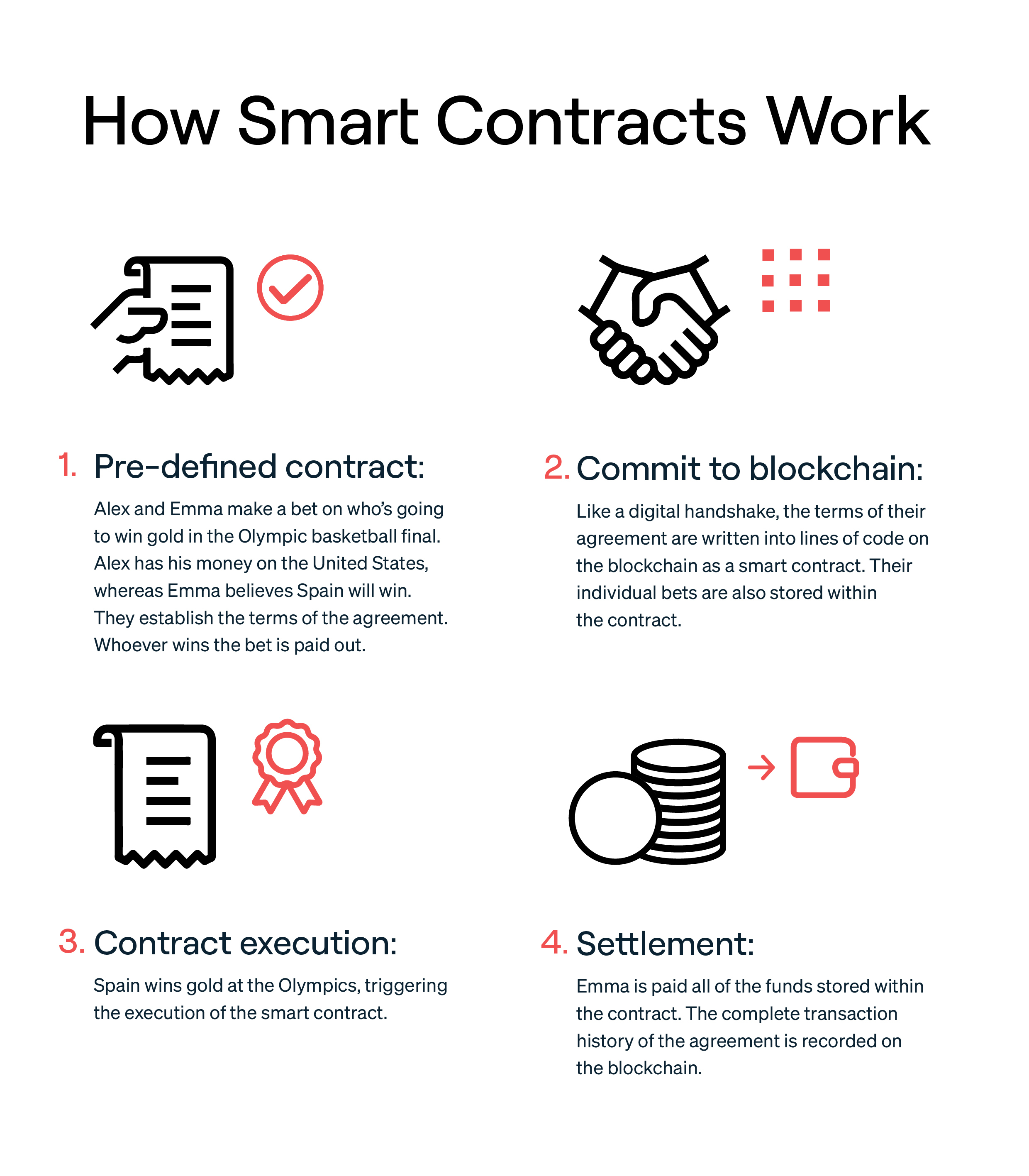
A Hybrid Consensus Model
Proof of History
The PoH protocol works to solve the issue of time agreement among validatory nodes, effectively recording a digital timestamp of all incoming transactions. With this timestamp already pre-recorded, validators have one less factor to consider when confirming transactions, effectively speeding up the PoS process. This hybrid consensus mechanism also uses significantly less computational power than other methods.
A simple way to think of PoH: You’re in the stands at a raceway. A car is coming down the straightaway at a ridiculous speed. You put your camera on burst mode and instantly snap a dozen photos in the millisecond that the car speeds by. Looking back on the moment through your photos, each one captures a specific moment in time as well as the exact location of the car on the track. From these shots, a sequence of time can be established and agreed upon by any other viewer of the photos. This is generally how PoH works.
Solana’s unique PoH consensus mechanism is considered to be a resolvable way to record transactions and/or events to its ledger. By solving the agreement on time first, the network can handle high transaction volume without incurring significant delays to transaction times that commonly plague crypto projects.
However, Solana has faced some reliability challenges, suffering multiple outages in 2022 and 2023. These issues appear to have been addressed.
Proof of Stake
After transactions are time stamped they are then validated via the PoS consensus mechanism. A user who has staked SOL—and operates a validator node—is randomly selected to validate a block of transactions. The more SOL you have staked, the higher the probability of selection.
Currently, there is no strict minimum to stake SOL. Users who choose to stake have two main options: participating as a validator or, delegating their SOL to be staked by a chosen validator.
Decentralised Apps (dApps)
Smart contracts also have paved the way for the creation and use of DApps. Like smartphone or computer applications, DApps have a wide range of functionalities. Rather than running on a central server, the code of a DApp is uploaded via a smart contract to the blockchain. Solana’s peer-to-peer network can then execute the app’s smart contract without the need for a centralised authority.
As of October 30th, Solana saw about one fifth of the users across its ecosystem of dApps versus Etheruem’s network, including the Layer 2 platforms – Optimism and Arbitrum – which ladder up to to.
NFTs
Although Ethereum dominates the NFT market, interest in Solana-based NFTs is growing. Creators, sellers, and buyers are attracted to the network due to its low fees. Even Ethereum-dominant marketplaces, like OpenSea, now host Solana NFTs.
Solana Program Library (SPL) Tokens
Solana also functions as a foundational layer (known as a Layer 1) for other crypto projects. Usually, the native tokens for these independent projects are Solana Program Library (SPL) tokens. You can think of SPL programming as a standard by which all tokens created on Solana have to abide by. Maintaining this standard increases the utility of the entire network, as Layer 2 projects have a level of backward compatibility with Solana.
Recommended reading: What is Proof of Stake in Crypto?
What is SOL?
SOL is the native crypto on the Solana network.
Many independent projects and assets run on the Solana network. These projects need to buy and use SOL to continue using the network by paying fees charged in SOL. Outside of this, SOL is distributed as a reward for validating transactions, used as payment in the buying and selling of NFTs, and the use of DApps.
Recommended reading: 6 Types of Altcoins & Their Uses
Advantages & Disadvantages of Solana
Solana has strived to become an efficient, accessible, and affordable blockchain network. As innovative as the project is, the goalposts for perfection are always moving. Let’s explore what sets Solana apart from other blockchains, as well as some challenges that the network is trying to overcome.
Advantages
- Low Fees: Solana boasts near-zero transaction fees across its network. And with the introduction of a new fee structure, fees will now be localised and dependent on activity within a certain part of the network. For example, if there’s a big NFT drop tomorrow on Solana, only those interacting with or minting the NFTs will experience increased fees. This unique approach to managing fee volatility is similar to surge or seasonal price changes in traditional markets.
- Proof of History: Solana’s unique PoH consensus mechanism is considered to be a reliable way to record transactions and/or events to its ledger. By solving the agreement on time first, the network can handle high transaction volume without incurring significant delays to transaction times that commonly plague crypto projects.
- Programmability: Solana's highly programmable networks allows newly developed DApps to interact with the many already existing protocols on the network. Like lego blocks, any smart contract, app, or protocol built on the network can interact or integrate with each other, leading to even more creative uses for Solana.
- Popular Programming Languages: Solana uses common programming languages, like C, C++, and Rust, a language that is growing in popularity yearly. Developers with no Web3 experience can easily transfer their skills to Solana, as opposed to other projects which have entirely unique languages.
- Tokenisation: Any item that can be registered in a digital format can be tokenised on Solana. While tokenisation is commonly used in the NFT space, it has real-world applications in real estate, art, and even gold. Think of it as a digital certificate of ownership for an asset.
- Eco-Friendly: Because Solana’s hybrid consensus model uses comparatively less computational power than other methods, Solana is often considered to be an eco-friendly crypto project. The network was made carbon neutral in 2021 and has committed to upholding this status into 2022 and beyond.
Disadvantages
- New Project: Compared to Bitcoin and Ethereum, Solana isn’t seen as well established. While it has had much success and consistently ranks among the top crypto by market cap, the project will have to continue to innovate and find more utility and adoption in order to scale.
- Downtime: While Solana boasts record speeds for a crypto project and very competitive fees, it is not a perfect blockchain. Solana has been subject to bugs and various events which have essentially halted the network. The most recent outage occurred after the network was compromised by hackers. The outage appears to have been spurred on by developers intentionally slowing down the network to discourage more fraudulent activity.
- Concerns Around Decentralisation: Solana has a higher than average validator count, a number that is often correlated with high decentralisation. However, a significant percentage of these validator nodes are concentrated in and maintained key data centres and somewhat centralised as a result. This leads some to believe that Solana may have a more centralised lean, as majority voting power and network maintenance lie in the hands of a few big organisations.
Who Created Solana?
In November 2017, Anatoly Yakovenko published a whitepaper introducing his concept of Proof of History. He strongly believed in the idea of a digital clock or method to timestamp all incoming blockchain transactions. PoH solved the problem of getting trustless validators to agree on time.
In the following years, he teamed up with previous Qualcomm co-workers—Greg Fitzgerald, Eric Williams, and Stephen Akridge—and founded Solana Labs. In early 2018, Fitzgerald began prototyping Yakovenko’s PoH concept. Later on, Akridge introduced a key improvement to Fitzgerald’s design that would make Solana the high-speed network that it is today.
In the next two years, the team raised money through a Series A round. They used the funds to continue building Solana’s Mainnet and smart contract features.
Solana was officially released to the public in March 2020 via an Initial Coin Offering (ICO).
A Brief History of Solana
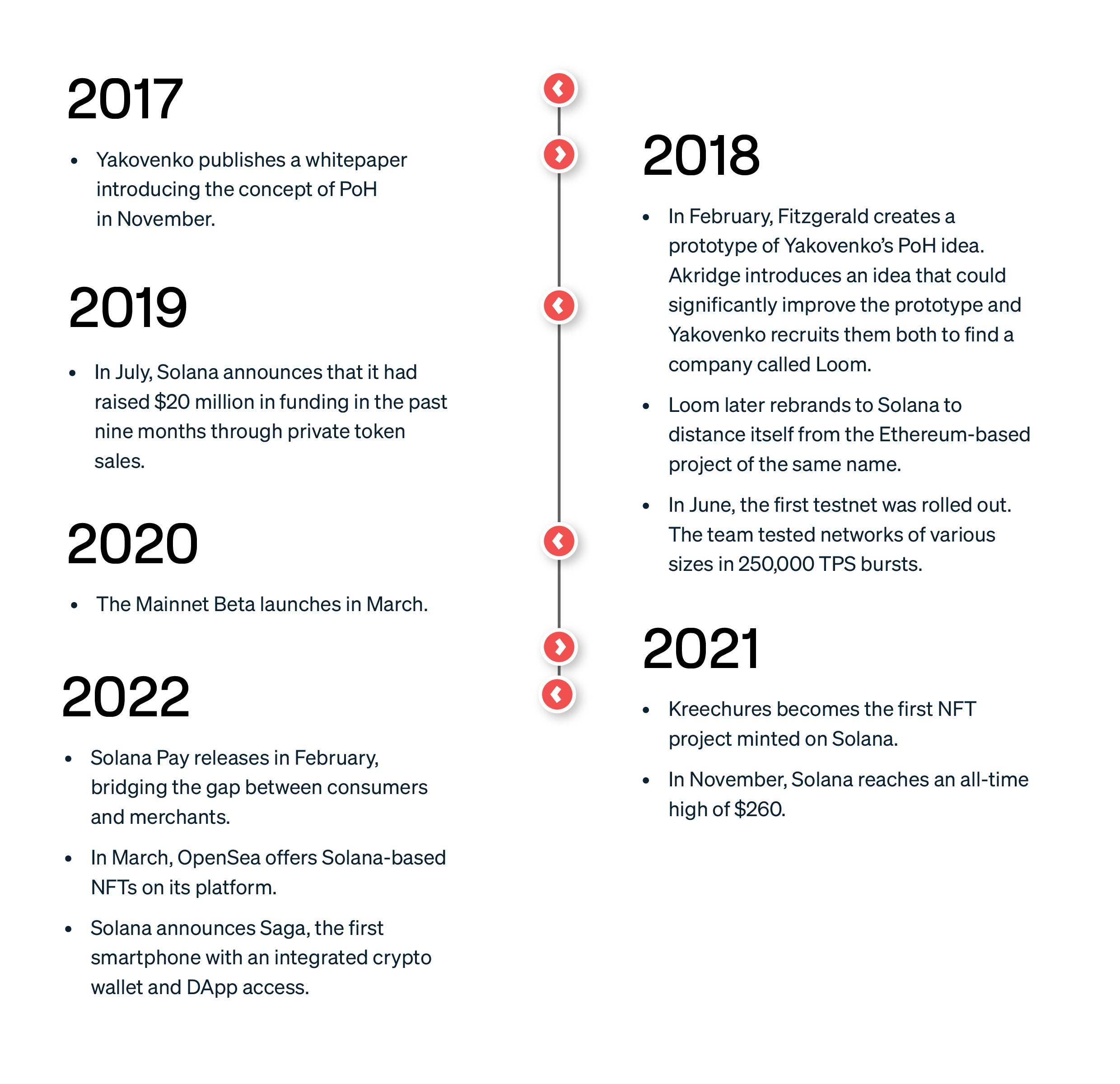
How to Invest in Solana (SOL) in 2023
Buying SOL
There are three primary ways to obtain SOL - buying, earning, or staking. While staking is relatively affordable on Solana, investors who do not have a validator set up will have to delegate their stake to an existing validator. If you prefer to have more control over your investment, consider buying SOL outright.
The easiest way to buy SOL is through a brokerage like Caleb & Brown. If you’re ready to dive in and make your first SOL purchase, Caleb & Brown is here to help. Trusted by over 25,000 investors across 100 countries, our dedicated team of experts works around the clock to carry out all your SOL trades.
Selling SOL
Selling your SOL with Caleb & Brown is as simple as buying. You can trade your SOL for any of the 100s of assets available through our brokerage.
Should you decide to exchange your SOL for fiat currency, there are $0 withdrawal fees as well.
How to Store SOL
There are multiple ways of storing SOL, from a cold wallet, hot wallet or with a custodian. Individual risk tolerance and preferences will determine the method employed by most users.
Cold wallets are completely disconnected from the internet. As such, they cannot be easily hacked and are often seen as a safer option for infrequent traders. These storage devices often resemble USB flash drives. Cold wallets have additional built-in layers of security to prevent a data breach once you connect it to the internet for trading.
Hot wallets are connected directly to the internet, usually through a phone or desktop application. Their popularity lies in their ease of use and ability to make trades quickly.
Many of these storage methods can seem complex, especially if you are not tech-savvy. Caleb & Brown provides end-to-end custody solutions for hassle-free storage and peace of mind investing. We have a battle-tested security infrastructure, through the leading asset security platform Fireblocks. All clients receive a free security consultation to ensure they follow security best practices.
Recommended reading: Crypto Security Part 1: Best Practices
What's Next For Solana?
While updates are ongoing for Solana’s Mainnet, the project is attempting to innovate in ways that other crypto projects are not. It even launched a smartphone, Saga, and it is a “purpose-built to power web3. Self custody on phone with Seed Vault. Access web3 native dApps. Experience the Saga difference.”
The smart contract platform continues to ship upgrades: broadening the features, improving performance and building more resilience into the network. You can see the October release here.
Developer participation on the Solana network has fallen or lagged has lagged other smart contract networks in the last few years – a trend worth keeping an eye on. Despite the drop-off, Solana remains the third biggest project in the crypto sector.
FAQs
Is Solana a good investment?
Choosing to buy SOL depends largely on your investment goals. Investors also weigh a variety of factors before choosing a project to invest in. Ultimately, it’s up to you to determine whether you decide to invest in SOL, and what strategies you use to maintain that investment.
At Caleb & Brown, we follow the facts; not opinions or trends. We encourage you to do your own independent research before making an investment. Our team of crypto experts are more than willing to answer any questions you have along the way.
Why does SOL have value?
Like any other asset, SOL’s value is determined by markets. It’s globally accessible, and people will readily buy SOL with other forms of money (e.g. dollars, euros, Bitcoin, etc.). People will use SOL as digital money to pay for goods and services, such as NFTs, DApps, or other coins. Knowing this, SOL has value because users will readily exchange it for other things considered valuable.
Yet understanding why SOL is at a certain price point is a more complex topic to unravel. It’s a delicate mix of investor belief in the value that the Solana project creates, along with some fundamental principles that should be met for an asset to be considered valuable.
For further insight into the value of crypto, we recommend reading our Why is Bitcoin Valuable explainer.
How many transactions can Solana do per second?
Currently, Solana averages around 2400 transactions per second (TPS).
What consensus mechanism does Solana use?
Solana currently uses a hybrid model which is a combination of Proof of Stake and Proof of History consensus mechanisms.
Invest in Solana (SOL) with Caleb & Brown
Investing in crypto doesn't have to be complicated.
Caleb & Brown is the world's leading cryptocurrency brokerage for those looking to invest in SOL or other digital assets.
Our personalised broker service makes crypto investing simple. A dedicated member of our broker team is always on hand to guide you along the way, giving you the confidence you need to navigate the world of crypto. Not to mention key features such as:
- No joining or signup costs
- Industry-leading storage solutions
- 24/7 customer support
If you are ready to take the next step and invest in SOL, contact your crypto broker today.
Not yet a client? Sign up for your free consultation.
Disclaimer: This assessment does not consider your personal circumstances, and should not be construed as financial, legal or investment advice. These thoughts are ours only and should only be taken as educational by the reader. Under no circumstances do we make recommendation or assurance towards the views expressed in the blog-post. Past performance is not a reliable indicator of future results. The Company disclaims all duties and liabilities, including liability for negligence, for any loss or damage which is suffered or incurred by any person acting on any information provided.
from Caleb & Brown Cryptocurrency Brokerage.
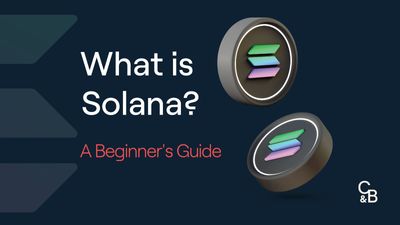
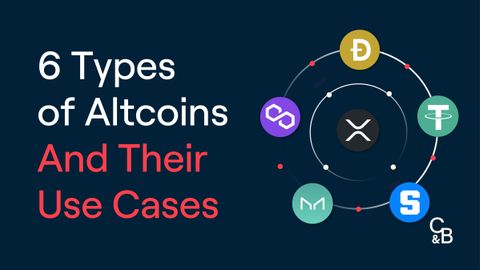
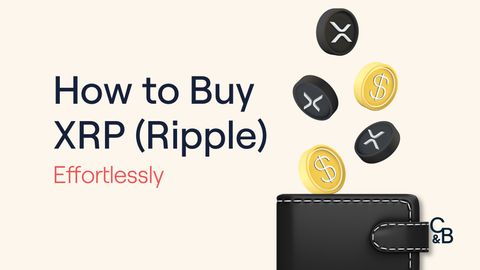
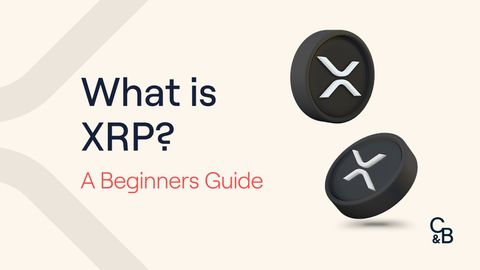
.png?u=https%3A%2F%2Fimages.ctfassets.net%2F4ua9vnmkuhzj%2F1PjLgWLIMUO2pzaZiPx5Dh%2F3348eab4e3ed605ef2edb43ec8e1f74f%2FBlog-Cover__15_.png&a=w%3D480%26h%3D270%26fm%3Dpng%26q%3D80&cd=2023-02-28T02%3A58%3A44.085Z)
